Rain Probability: A Fancy Way to Say 'Maybe, Maybe Not'
Understanding how rain probability works and why it’s the weather forecast’s way of saying “who knows?”

Image by gpointstudio on Freepik
Rain probability is one of those terms that often leaves us scratching our heads. “There’s a 40% chance of rain today,” the forecast says, but what does that really mean? Is it going to rain or not? With that number in hand, you might find yourself staring out the window, wondering whether you should carry an umbrella or leave it behind. In the world of weather forecasting, rain probability is a tool used to give you an idea of how likely it is that rain will occur—but it’s not a guarantee. In fact, it’s just a fancy way to say “maybe, maybe not.” Let’s break down what rain probability actually means and why it’s so hard to predict the weather precisely.
1. What Does Rain Probability Really Mean?
When a weather forecast tells you that there’s a 40% chance of rain, it’s based on a combination of several factors, such as atmospheric conditions, radar data, and historical patterns. But the percentage itself doesn’t mean “40% of your area will get wet,” nor does it mean there’s a 40% chance that you will get rained on. It refers to the likelihood that measurable rain (usually at least 0.01 inches) will occur somewhere in the forecasted area. In short: it’s not a personal forecast for you, it’s a generalized prediction for a larger region.
2. How Forecasts Determine Rain Probability
To determine the probability of rain, meteorologists use sophisticated tools like weather satellites, weather radar, and computer models that simulate how the atmosphere behaves. These tools take into account the moisture levels in the air, cloud coverage, and various other atmospheric dynamics. For instance, if meteorologists notice a large mass of moisture moving in and conditions are right for rain, they might forecast a high probability of rain. However, the weather can be unpredictable, which is why we often see forecasts with varied percentages. Even with advanced technology, weather forecasting is still an inexact science.
3. Rain Probability Is About the Bigger Picture
Rain probability doesn’t necessarily mean you’ll be getting soaked, but that it’s possible within the given region. For example, a forecast might show a 50% chance of rain in a large city, but this doesn't mean the entire city will be affected. It simply means that there’s a 50% likelihood that at least part of the area will experience rain at some point during the day. The weather could be sunny in one neighborhood and rainy in another. So, even with a high probability of rain, it’s not guaranteed that everyone will be hit by the downpour. It’s all about the probability of rain occurring somewhere in the forecasted zone.
4. Why Weather Predictions Aren’t Perfect
Weather predictions are inherently uncertain. The atmosphere is complex, with countless variables influencing how it behaves. While meteorologists can use past data and sophisticated tools to make predictions, it’s still difficult to account for every factor that could influence weather conditions. For example, small shifts in temperature, pressure, or wind patterns can dramatically alter whether or not rain will occur. This is why we often hear percentages like 30%, 50%, or even 80% chances of rain—they reflect how confident meteorologists are in their predictions, but there's still room for error. Sometimes, rain might not come at all, or it might be heavier than expected.
5. How to Make Sense of Low vs. High Rain Probability
When the forecast says there’s a low chance of rain, say 10% or 20%, it’s a good bet that you can leave the umbrella behind and carry on with your day. However, even with low probabilities, unexpected showers can still happen, so keep an eye on the sky and carry an umbrella just in case. On the flip side, when the forecast predicts a high chance of rain—like 70% or 80%—it’s likely that you’ll want to prepare for wet conditions. While high rain probabilities suggest a strong likelihood of rain, they still leave room for uncertainty, so it’s always good to stay flexible in your plans.
6. Why Does It Sometimes Feel Like the Forecast Is Wrong?
If you’ve ever had a day where the forecast predicted rain, but the skies stayed dry, you might have felt a little frustrated. But remember, weather forecasts aren’t set in stone. Meteorologists are predicting based on patterns, but the weather can change rapidly. The 40% chance of rain could mean that in some places it rained heavily, while in others, it stayed dry. It can also happen that conditions shift unexpectedly, causing rain to arrive later than predicted or, in some cases, not at all. As a result, the forecast might seem wrong, but it’s simply reflecting the inherent uncertainty of weather prediction.
7. How to Use Rain Probability in Daily Life
Understanding rain probability can help you make better decisions throughout your day. Here’s how to use this information effectively:
- Low probability (0-30%): It’s probably safe to leave your umbrella behind, but be prepared for the possibility of a quick drizzle.
- Medium probability (40-60%): Carry an umbrella or light rain jacket just in case, as rain could hit at any time.
- High probability (70% or higher): Prepare for rain. Bring an umbrella, waterproof gear, or consider adjusting your plans to stay indoors if you want to avoid getting soaked.
8. Why It’s Still a Good Idea to Check the Forecast Anyway
Even though rain probability isn’t an exact science, it’s still a valuable tool for planning your day. Checking the weather forecast gives you a heads-up on what to expect and allows you to adjust your plans accordingly. Even if the forecast isn’t perfect, it can help you make informed decisions, whether that’s carrying an umbrella, altering your outdoor plans, or just mentally preparing for a rainy day.
So, the next time you see a weather forecast that says there’s a 50% chance of rain, you’ll know that it’s just a fancy way of saying “maybe, maybe not.” Embrace the uncertainty, stay prepared, and remember: weather predictions are guides, not guarantees!











